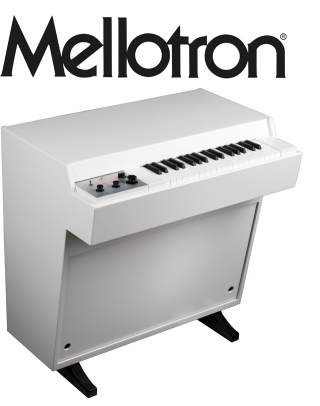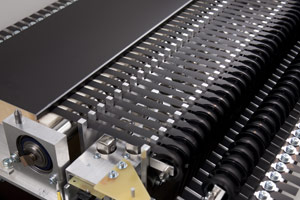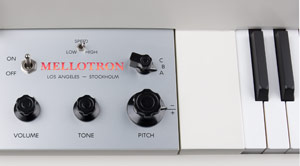Mellotron
Our Mellotron library is the very successful result of a unique cooperation, where the original Mellotron tape banks has been sampled and is now offered to Nord players around the world owning a Nord Sample Library compatible product.
The Mellotron History
In the early 1960's Bill Fransen, one of Harry Chamberlin's employees, took one or two Chamberlin Musicmaster 600 (a dual-manual machine with 36 sounds) to the UK. He presented this unit to a British firm run by the Bradley brothers, asking if they could improve on the design by providing matched tape replay heads.

The Bradley brothers said yes, and the Musicmaster 600 essentially became the blueprint of the Mellotron MkI and the launch of the company named Streetly Electronics. At that time the British did not know that the instrument had US origin and was protected by several patents, but eventually the Bradley's and Chamberlin came to a business agreement and both companies could develop the initial ideas and design further.
Chamberlin e.g. started to use 1/2 inch, 8 track tapes with stereo capabilities while Mellotron went about making the units more affordable and portable. The first Mellotron had the same basic layout as the Chamberlin 600 with 2 manuals, the left one having rhythm tracks to be played as a background, and the right one having lead sounds like strings, flute and lots of organ sounds.
Early adopters soon began modifying this layout by simply replacing the rhythm tapes with an extra set of lead sounds. One of the most famous example of the use of a double lead instrument keyboard is perhaps the intro of Genesis' Watcher of the Skies: left hand keyboard= accordion; right hand keyboard = violins + brass. According to Tony Banks himself the introductory section of this song was intended to take advantage of the tonal strengths of the Mellotron MkII he was using at the time.
"The first models were basically intended to be a home organ, like a home entertainment center where someone without music skills could sound like an orchestra"
Probably the most famous Mellotron rhythm sound is the introduction to ''Bungalow Bill'' on the Beatles white album. The first models were basically intended to be a home organ, like a home entertainment center where someone without music skills could sound like an orchestra. Unfortunately it was very hard to play rhythms like that, even for trained musicians, and together with some technical flaws and bad engineering it wasn't too much of a success - many of the first series of instruments had to be taken back to the factory and upgraded from MkI to MkII.
Luckily young and creative professional musicians had become interested in the Mellotron, and the MkII became extremely popular amongst pop/rock groups in the late 1960's: Manfred Mann, Beatles, Rolling Stones, Moody Blues, King Crimson and others. The MkI and MkII units are big things, with a dark wood, organ style cabinet, two 12 inch internal speakers with accompanying amplifier and a weight of approx. 160 kg (351 lbs). The Mellotron M400 was launched in 1970.
This was a smaller instrument with one keyboard with 35 keys, in a white colored polished wood cabinet. It had a new sound library even though some of the older sounds also could be used. It weighed ''only'' 55 kg (122 lbs) and used 3/8-inch tapes with three sounds on each tape. This was a very successful unit, with more than 1800 sold.
Use of the Mellotron sounds
 Although the Mellotron had been used earlier by some British bands, the song Strawberry Fields Forever by the Beatles (Flute) and Nights in White Satin by the Moody Blues (3 Violins) in 1967 became the first Mellotron ''hits'' both in Europe, the US and the rest of the World, forever making a mark in popular culture.
Although the Mellotron had been used earlier by some British bands, the song Strawberry Fields Forever by the Beatles (Flute) and Nights in White Satin by the Moody Blues (3 Violins) in 1967 became the first Mellotron ''hits'' both in Europe, the US and the rest of the World, forever making a mark in popular culture.
The M400 was used on the road and in the studio during the 1970's by Led Zeppelin, Pink Floyd, Genesis, Yes, Deep Purple, Aerosmith, Wings, David Bowie and others. During later years it has been used by Oasis, Primal Scream, Radiohead, Smashing Pumpkins, Red Hot Chili Peppers, U2, Nelly Furtado, Air, REM, Manic Street Preachers and many others. Through the extremely successful music of these groups and artists the Mellotron sound has been widely spread, and even though most people don't know that it's a Mellotron, they've heard the sound.
During the 80's the Mellotron remained virtually unused. Most notable exceptions are Talk Talk in Life's what You Make it and OMD's Joan of Arc and other songs by these bands. The Mellotron experienced a renaissance during the 1990's when numerous bands and artists began reusing it; Red Hot Chili Peppers, Lenny Kravitz, Oasis, Radiohead, Air, Monster Magnet, REM and Manic Street Preachers. After 2000 the Mellotron is gaining even more popularity and has been used on hits by Dido, Nelly Furtado, Daniel Powter, Robyn, The Black Eyed Peas and The Strokes to name a few.
Faithful recreation
 The Nord Sample Library versions were made of the 63 most well known lead sounds from the Mellotron sound library, using super fresh tapes that were printed directly from the original masters. These tapes were then used in a brand new Mellotron mk VI, that uses new mechanics and state of the art technology, but original unused stock tape heads.
The Nord Sample Library versions were made of the 63 most well known lead sounds from the Mellotron sound library, using super fresh tapes that were printed directly from the original masters. These tapes were then used in a brand new Mellotron mk VI, that uses new mechanics and state of the art technology, but original unused stock tape heads.
If you have Spotify, you can listen to some of the songs that made the Mellotron sounds so famous here: Mellotron
